It’s come to that.
I’ve been sick of my country for a long time,
Ever since I stopped being a kid.
When I learned about the atomic bombing of Japan.
Then Vietnam brought it home.
I was writing Romantic poetry
Until the age of 12.
Then my poetic soul
Gently urged me to wake up.
I woke up like Neo in the Matrix
In a bath of amniotic fluid
Covered with suctioning electrodes
Which I pulled off,
Gasping for air
Like a premature newborn
Adult human being.
All Romantic notions
Of One Nation Under God,
Hand to the heart,
Swearing allegiance became just swearing.
Something hit the window of my house of mirrors.
I picked up the still-warm
Bird of my youthful soul
And got sick right there,
Sick of my country.
I have nothing to prove to my country.
No loyalty.
My country needs to win me back.
Hand over heart, face mask for protection.
Stop making us sick.
—Gary Lindorff
My Lai (a book review) PART ONE
A book review of:
MY LAI: VIETNAM, 1968, AND THE DESCENT INTO DARKNESS
By Howard Jones
Oxford: 2017
(This review first appeared in The Mekong Review, published in Leichhardt, Australia)
[Click here to go to Part Two]
Monsters exist, but they are too few in number to be truly dangerous. More dangerous are the common men, the functionaries ready to believe and to act without asking questions.
– Primo Levi
On 17 March 1968, the New York Times ran a brief front-page lead titled “G.I.’s, in Pincer Move, Kill 128 in a Daylong Battle”; the action took place the previous day, roughly thirteen kilometres from Quang Ngai City, a provincial capital in the northern coastal quadrant of South Vietnam. Heavy artillery and helicopter gunships had been “called in to pound the North Vietnamese soldiers”. By three in the afternoon, the battle had ceased, and “the remaining North Vietnamese had slipped out and fled”. The US side lost only two killed and several wounded. The article, datelined Saigon, had no byline. Its source was an American military command’s communiqué, a virtual press release hurried into print and unfiltered by additional digging.
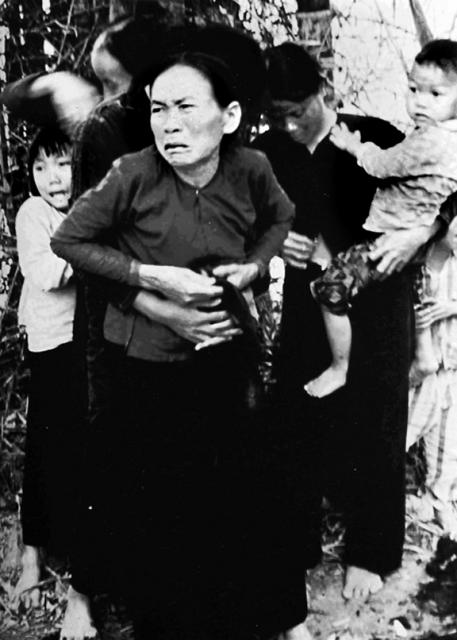 My Lai residents moments before being shot (Ron Haberle/WikiCommons)
My Lai residents moments before being shot (Ron Haberle/WikiCommons)
Several days later, a more superficially factual telling of this seemingly crushing blow to the enemy was featured in Southern Cross, the weekly newsletter of the 23rd Infantry (or Americal) Division, in whose “area of operation” the “daylong battle” had been fought. It was described by Army reporter Jay Roberts, who had been there, as “an attack on a Vietcong stronghold”, not an encounter with North Vietnamese regulars, as the Times had misconstrued it. However, Roberts’s article tallied the same high number of enemy dead. When leaned on by Lieutenant Colonel Frank Barker, who commanded the operation, to downplay the lopsided outcome, Roberts complied, noting blandly that “the assault went off like clockwork”. But certain after-action particulars could not be fudged. Roberts was obliged to report that the GIs recovered only “three [enemy] weapons”, a paradox that warranted clarification. None was given. It was to be assumed either that the enemy was poorly armed or that he had removed the weapons of his fallen comrades — leaving their bodies to be counted — when he retired from the field. Neither of the news outlets cited here, nor Stars and Stripes, the semi-official newspaper of the US armed forces, which ran with Roberts’s account, makes reference to any civilian casualties.
It would be nearly eighteen months later when, on 6 September 1969, a front-page article in the Ledger-Enquirer in Columbus, Georgia, reported that the military prosecutor at nearby Fort Benning — home of the US Army Infantry — was investigating charges against a junior officer, Lieutenant William L. Calley, of “multiple murders” of civilians during “an operation at a place called Pinkville”, GI patois for the colour denoting human-made features on their topographical maps of a string of coastal hamlets near Quang Ngai.
With the story now leaked, if only in the regional papers — it would migrate as well to a daily in Montgomery, Alabama — the Fort Benning public information officer moved to “keep the Calley story low-profile” and “released a brief statement that the New York Times ran deep inside its September 7, 1969 issue”, limited to three terse paragraphs on a page cluttered with retail advertising. The press announcement from the Army flack had referred only to “the deaths of more than one civilian”. In the nation’s newspaper of record, which also mentioned Calley by name, this delicate ambiguity was multiplied to “an unspecified number of civilians”. Yet, once again, the Times had been enlisted to serve the agenda of a military publicist and failed to approach the story independently.
My Lai (a book review) PART TWO
A book review of:
MY LAI: VIETNAM, 1968, AND THE DESCENT INTO DARKNESS
By Howard Jones
Oxford: 2017
[Click here to return to Part One]
(Continued)
First before the bar at Fort Hood, Texas, in November 1969 was Calley’s platoon sergeant, David Mitchell, whom witnesses described as someone who carried out the lieutenant’s orders with particular gusto. Then in January it was Sergeant Charles Hutto’s turn at Fort McPherson, Georgia. Hutto had admitted turning his machine gun on a group of unarmed civilians. These two men were so patently guilty in the eyes of their own comrades that theirs were among the strongest cases the investigators had constructed for the prosecution. Both men were acquitted in trials that can only be described as judicial parodies.
At Mitchell’s trial the judge, ruling on a technicality, did not allow the prosecution to call witnesses with the most damning testimonies, like Hugh Thompson. Hutto had declared in court that “it was murder”, but claimed “we were doing it because we had been told”. When the jury refused to convict him because Hutto had not known that some orders could be illegal, Jones nails how the court was sanctioning “the major argument that had failed to win acquittal at Nuremburg”.
Shortly after Hutto’s trial, the Army dropped all charges against the remaining soldiers, fearing their claims to have been following orders would likewise find merit in the prevailing temper of the military juries. Heeding the judicial trend, Lieutenant General Jonathan Seaman, a regional commander exercising jurisdiction over officers above the rank of captain, dropped all charges against Major General Koster. By some opaque calculation that convinced no one, Seaman had concluded that Koster was not guilty of “intentional abrogation of responsibilities”. A hue and cry followed in the press and on Capitol Hill, denouncing Seaman for “a whitewash of the top man”. The outcry did prod the Pentagon to take punitive action against Koster. The general had already been dismissed as the commandant of West Point, and he was now demoted to brigadier general and stripped of his highest commendation.
Seaman informed Koster, through internal channels, that he held him “personally responsible” for My Lai, a kind of symbolic snub among gentlemen. But in exonerating the Americal commander, Seaman had — by design, it can be argued — inoculated the higher reaches of command, right up to General Westmoreland, from being held responsible for the actions of their subordinates, a blatant act of duplicity in light of the ruling at the Tokyo trials after the Second World War, where a lack of knowledge of atrocities committed by his troops had not prevented General Yamashita from being sentenced to death.
With Calley’s court martial already in progress, only three other officers remained to be tried: Medina and the Task Force Barker intelligence officer, Captain Eugene Kotouc, for war crimes, and 11th Brigade commander Henderson, for the cover-up. Jones deftly unspools how the flawed and self-protective system of military justice enabled trial judges in each case to provide improvised instructions to their juries that all but dictated the acquittal of all three men. Kotouc had been charged with murdering a prisoner, whom, given the available evidence, he almost certainly had; still the jury found him not guilty in less than an hour. Asked if he would stay in the military, Kotouc gushed, “Who would get out of a system like this … it’s the best damn army in the world.” 2
Historic Recognition For MLK 'First' In New Jersey Moves At Snails Pace
 House in Camden, NJ (left) where Dr. Martin Luther King Jr. plotted a protest that produced his first lawsuit against discrimination.
House in Camden, NJ (left) where Dr. Martin Luther King Jr. plotted a protest that produced his first lawsuit against discrimination.
The first lawsuit against discrimination ever filed by Dr. Martin Luther King Jr. – the iconic civil rights activist – is of questionable historic value according to an unusual study released recently by New Jersey state historic preservation authorities.
New Jersey’s Historic Preservation Office (HPO) paid $20,000 for the study as part of its review of an application seeking historic designation for a property in Camden New Jersey where Dr. King stayed occasionally while attending seminary school in Chester, Pennsylvania over 60-years-ago.
King, according to new documentation unearthed by a NJ researcher, began formulating the protest that led to his first anti-discrimination lawsuit, while at the 753 Walnut Street Camden property. King was at the house hours before going to Maple Shade, NJ, where a white café owner refused service to King and his three companions in June 1950, chasing them from that café with a gun.
King listed 753 Walnut Street Camden as his address on police reports from that gun toting service denial encounter.
That Maple Shade café incident produced King’s first anti-discrimination lawsuit. King, during an October 1961 conversation with news reporters in Philadelphia, Pa, described that incident as a “painful experience.”
That study is the first study ever commissioned by NJ’s Historic Preservation Office, the office in charge of NJ’s Register of Historic Places.
HPO records list 51,825 properties and sites on NJ’s historic register, as of February 2018. The thousands of private properties on that historic register were approved without a study like the one conducted on the Camden property, an HPO spokesman noted.
Are We Living Under a Military Coup?
If President Trump is convicted of a crime or is impeached, will he go gracefully like the experienced politician Richard Nixon — or will he go out like Jimmy Cagney atop a giant gasoline tank in White Heat? “Top O’ the World, Ma!” Think of the institution of the presidency as that gasoline tank that goes up in a huge fireball at the end. Translated into the context of Reality TV, think of the narcissistic star-in-chief playing out the final episode under the delusion he’s still in control with his i-phone — to the bitter end stirring up a pumped and well-armed base. Sensationalistic, for sure. But implausible?
The part of this improbable administration that’s not a reality TV show centered on a narcissistic billionaire and his plutocrat cabinet is the anchor represented by Chief of Staff John Kelly — along with Defense Secretary James Mattis and Security Adviser H.R. McMaster. If this were a Herb Block cartoon from the 1970s, they’d be a very stolid rhinoceros standing in the midst of Oval Office wreckage with words on its flank that read NATIONAL SECURITY STATE.
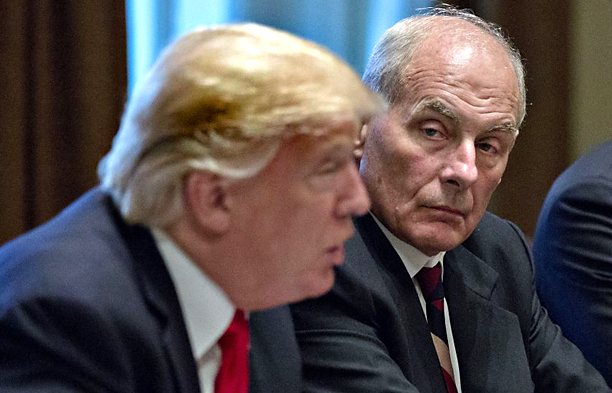

The loose cannon president and his National Security State minder?
The National Security Act of 1947 codified the reality of the imperial American military for the baby-boom generation and beyond. The War Department became the Defense Department; the CIA we know today was formed from the Office of Strategic Services. The 1947 NSA document amounted to a formal re-arrangement of the country’s priorities coming out of WWII — when the victorious United States of America became the “leader of the free world.” We forget that before World War Two changed everything, the US military was a shadow of what it was to become.
Over these 70 years, the executive in the White House has ping-ponged back-and-forth between the moderate left and the moderate right, between the Democratic and Republican Parties. (Trump may be the exception in being far right.) Every four years there‘s a national “conversation” of sorts about who’s going to live in the White House and make executive decisions and who’s going to legislate in Congress. You couldn’t come up with a better example to illustrate the idea of a civilian political see-saw than January 20, 2016, the day Barack Obama handed the civilian reins over to Donald Trump. Meanwhile, over those same 70 years, the National Security State (as an institution led by the Pentagon) has existed as a steadily ascending through-line leading to today’s post-9/11 world. Our imperial military has been, and remains, virtually untouchable through the electoral process that chooses civilian leadership. Just like assault weapons on a small scale, the National Security State thrives beyond the reach of American politics. In my mind, White House Chief of Staff and former four-star Marine General John Kelly resides in this protected zone as a power behind the civilian throne — there looking out for Pentagon interests and there in case the gasoline tank goes up in a fireball. It’s also good to remember that Donald Trump was groomed in military school, where he thrived. He clearly didn’t wish to go to Vietnam, but military discipline has been good for his self-aggrandizement. Thus, real combat leaders may hold a unique sway over The Donald.
When Kelly was pulled from Homeland Security into the chaotic Trump White House to replace the ineffectual Reince Priebus, it was like Randolph Scott had ridden in to tame a wild-and-wooly town. Since his arrival, he’s made two things clear: one, he feels the US military is sacrosanct and beyond questioning, and two, he’s in full synch with Trump’s nostalgic sentiments that incorporate white supremacist instincts.
It's North Korea's Kim Jong-un, not Trump, who Forced the US to the Negotiating Table
 North Korea's Kim Jong-un inspects a new H-bomb while US troops in South Korea prepare for war (US Army photo)
North Korea's Kim Jong-un inspects a new H-bomb while US troops in South Korea prepare for war (US Army photo)
I’m no fan of police states or of dictators, whether in Russia, China, North Korea or under development here in the United States, but let’s at least be honest about what’s behind the news that President Trump has agreed to meet with North Korean leader Kim Jong-un, the man he has been calling “fat” and “Rocket Man.”
The corporate media in the US have been lavishing at times grudging praise on Trump, claiming that it was his “harsh sanctions” and threatening military moves around the Korean Peninsula, and leaked White House talk of “bloody nose” incursions into North Korea, or threats to destroy that country that forced Kim to agree to talks.
The reality is quite the opposite, though. While we may be loath to admit it, that truth is that it has been Kim’s dogged persistence, in the face of US sanctions, boycotts and threats, in testing and developing both a credible nuclear arsenal of atomic and thermonuclear weapons, and in demonstrating that he has missiles that can reach US targets, probably including the lower 48 states.
With as many as 60 such deliverable weapons, according to some estimates, Kim’s North Korea has reached a point where the only way the US could hope to undo his accomplishment would be an all-out war against the North and his one-million-man army, its dug-in artillery. And even then the chances of doing this without North Korea launching at least some of its nukes would be slim.
Credit should go also to South Korea’s President Moon Jae-in, who has defied the US by reaching out to Kim, first by inviting North Korea to participate in the Winter Olympics just completed successfully in South Korea (including the fielding of a joint North and South Korean women’s hockey team), and then offering to meet directly in the North with Kim. Moon later had his national security advisor deliver to the White House Kim’s invitation to meet with President Trump.
Learning the Power of Protest, Confrontation and Collective Action, Where Will America’s Students Go from Here?
A salute to the kids of the Marjory Stoneman Douglas High School in Parkland Florida!
After experiencing a terrifying attack on their school by a tragically unhinged former student armed with an assault-style rifle who killed 14 of their classmates and three teachers and seriously injured another 14, they didn’t retreat into fear and victimhood. Instead they are taking to the streets, taking to buses to the state capital in Tallahassee, and are using social media to organize a national youth campaign to get assault weapons and large-capacity magazines banned.
In refusing to be silenced by the National Rifle Assn. and political charlatans like Florida Sen. Marc Rubio or President Trump, or co-opted by Democratic politicians eager to use the issue of gun control to win points in next November’s congressional elections, these students and the tens of thousands of high school kids who have joined them across the country in states blue, red and purple, they have in one stroke revived the idea of mass political action.
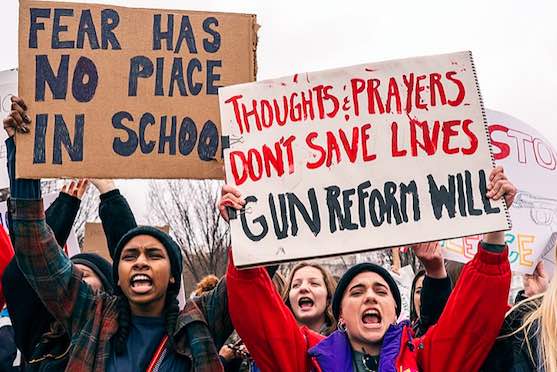 Students from the Marjory Stoneman Douglas High School may have sparked a national student protest movement
Students from the Marjory Stoneman Douglas High School may have sparked a national student protest movement
These kids are not being polite. When someone like Sen. Rubio or Florida Gov. Rick Scott or the Florida state legislature comes up with an excuse like blaming the shooting on mental illness rather than the easy availability of mass-killing military-style weapons, they shout “BS!” When they’re told the answer is to arm teachers, they shout “BS!” When they’re accused of being “paid crisis actors” or manipulated, they shout “BS!” And when the Florida legislature insults them by ignoring their mass trip to the state capital to demand a hearing on gun legislation, they mass in front of the statehouse, shout “BS!” and demand to be heard.
The whole political battleground over gun ownership in the US has just undergone a tectonic shift as great as if a 9-point tremor had struck. For the first time in memory, huge corporations like Delta Airlines are abandoning their backing for the NRA, dropping lucrative and once popular marketing discount programs for NRA members on pain of being boycotted — a threat that has even gigantic companies like Apple and Amazon worried. No wonder the NRA had their latest version of spokesman Charlton Heston, Dana Loesh, put out a short ad in which,looking like the Wicked Witch in the Wizard of Oz, she poses in black with a giant hourglass, darkly warning the “lying media,” Hollywood “phonies,” unpatriotic athletes, politicians who “watch America burn” and late night hosts,” that “Your time is running out — the clock starts now.”
The gun lobby making this threat is suddenly running scared. Like that other top lobbying organization, the pro-Israel lobby AIPAC, which was stood up and ignored by Democratic presidential candidate Bernie Sanders in 2016, their bluff has been called. Once cowed politicians are realizing they can stand up to such lobbies and still retain or maybe even gain support among voters, it’s their days that are numbered.
Will the student movement, on this once sacred issue of gun rights, succeed? I’m guessing it will. It already has on some level. Perhaps they’ll get AR-15 style weapons banned and also large magazines for semi-automatic weapons. Maybe they’ll only get the guns themselves banned for sale to people under 21. But they’ll get something.
And that raises the crucial question: is this the beginning of something bigger? Sure this issue of stopping the sale of instruments of slaughter has tremendous resonance following such a horrific shooting, and thanks to the spontaneous rising of a nation of angry students — teens in high schools and 20-somethings in college — but are these once polite and agreeable students going to take their new found in-your-face, “up-against-the-wall” political activism and apply it to other issues?
Black Panther: An Amazing Moment for People of Color, An Okay Moment for Women
As a queer woman, when it comes to film, I fulfill pretty much all of the stereotypes. I don’t really like action films. I am underwhelmed by special effects and action sequences. As my wife once complained, “All the movies you like… nothing happens in them.” My undergraduate thesis was on documentary film theory. I am, absolutely, one of those insufferable film snobs.
I love Black Panther.
Even as I state that, I feel confused. It’s just an action flick, which superficially doesn’t really have much to write home about. The acting was fine. Nothing particularly stand-out, but no cringe-worthy moments either. The action sequences were similar. Fun special effects, but really nothing revolutionary.
But of course, we all know that given the world we live in, Black Panther is so much more. The entire film is like a live-action Kehinde Wiley exhibit and it was just as emotionally powerful.
As you’re introduced to the nation of Wakanda, it’s the first time you’ve ever seen elements of African culture embedded in an empowered society. As if that were how it always was. For once, you’re not given a choice between poverty and beautiful, colorful textiles and armbands. It’s a breath of fresh air when you didn’t even know you were suffocating.
Literally, simply the setting of the film choked up my chest and brought tears to my eyes. My right foot, left arm, and whole face started tingling. Wondering if I was losing circulation, I uncrossed my legs and tried to spread out my arms. Nope. Still tingling. Those images are just that powerful. Cathartic in so many ways, I was saddened when it all came to an end. Never in my lifetime did I think that I would get to witness a white man being called “colonizer” as a joke in a mainstream, Hollywood film. There’s even a token white character who has the refreshing role of taking orders and being willing to sacrifice his life in pursuit of the greater good!
As I sat there, reveling in the images, I couldn’t help but yearn for my own version. I thought, it would be so incredible to see an Asian movie like this!
Like any good action film, it plays with larger philosophical issues in between stunts and guns. The eternal debate between liberation by “any means necessary” and non-violence is the crux of the conflict in the film. I appreciated the poignancy of N’Jadaka’s character, played by Michael B. Jordan, illustrating intergenerational trauma. It reminds us that even if we were able to miraculously stop the pervasive mass incarceration and over-policing of Black communities tomorrow, the psychological impacts would exist for generations to come.
But a third of the way through the film, I still couldn’t help but wonder to myself: “Don’t men know how to do anything besides fight and wage civil wars?” The entire conflict, climax, and resolution of the movie revolve around a battle for the throne from two men in the royal bloodline. The king is dead and the privileged but kind-hearted and wise son, T’Challa, played by Chadwick Boseman, takes his place. Just as this happens an unknown son of the bloodline, N’Jadaka (aka Erik “Killmonger” Stevens), resurfaces after being abandoned in the slums of Oakland, CA. 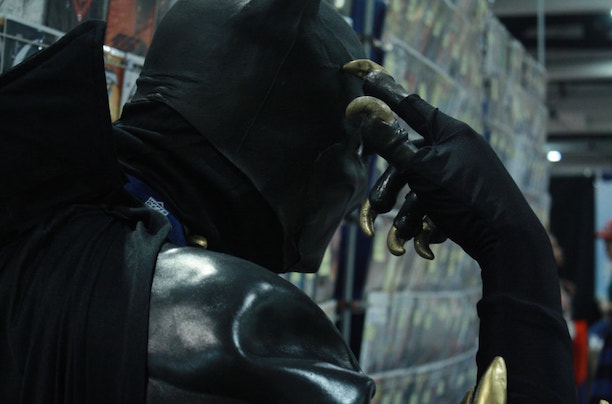
Idiocy 101: Arming Teachers To Stop Mass Shootings In Schools
So President Donald Trump now pontificates that he would run into a school building to save students during a mass shooting attack even if he was “unarmed!”
This empty boast is from the same Trump who failed the bravery test during the Vietnam War by dodging the draft — not for principle but because the poor guy had “bone spurs” on one foot (he can’t remember which).
Yes, that braggadocio is on top of other asinine blather from the Oval Office occupant. Trump for example made that boast while taking another shot at the police who failed to rush into that south Florida high school during the Valentine’s Day 2018 massacre that left 17 dead including 14 students.
The unwillingness of armed cops outside that Parkland high school to rush inside to confront an assault rifle firing shooter didn’t stop pseudo Tough Guy Trump from pushing the asinine proposal to arm teachers to help stop mass school shootings.
The Trump who wants to pay teachers to carry guns in schools is the same Trump who wants to slash billions of dollars in federal funding for education.
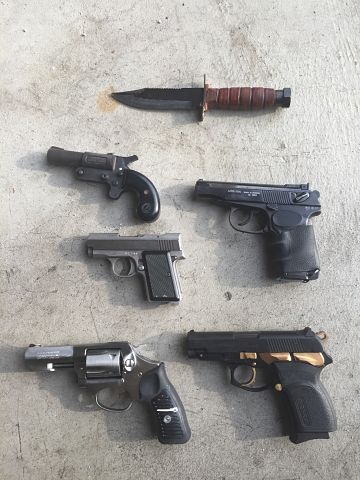 Arming teachers is a big pay day for gunmakers. It doesn't make America great or safe.
Arming teachers is a big pay day for gunmakers. It doesn't make America great or safe.
Since Trump never lets facts stand in the way of his fantasies, he doesn’t care that a study conducted by his hometown police force – – the New York City Police Department –- found police only had an 18 percent success rate in hitting a person they were shooting at if that person was shooting back at them.
That begs the question: In arming teachers, does Trump accept that teachers will almost inevitably accidentally kill a few students while trying to shoot a mass shooter, given the NYPD certified fact that even trained police, who are regularly retrained on shooting guns accurately, have such a poor ‘good shoot’ percentage in shootout situations?
Washington has Long Engaged in Information Warfare, Including Fake News and Trolling
The howling in government and the corporate media and among many liberals about an alleged Russian information war, with bots, trolls and fake news being placed in social media to mislead and incite Americans against each other, might lead one think, like Sen John McCain, that we are practically at war with Russia. Yet it’s all actually pretty silly. After all, our own government has been playing this game for decades, both abroad, and also right here inside the “Land of the Free and Home of the Brave” and against us American citizens.
I know. I was a victim of such an attack, though initially I didn’t realize what was happening.
Back on August 25, 2005, I published a piece in In These Times titled Radioactive Wounds of War about the devastating damage caused by the US military’s use of depleted uranium weapons in its brutal assault leveling Fallujah, the Iraqi city of 300,000 people that was destroyed by US marines in 2004 as retribution for the killing of four US contractors by the Iraqi insurgents who at the time controlled the city, and for their humiliating defeat of a smaller Marine assault on the city earlier in the year.
At the time I was and had been a contributing editor at ITT, a publication for which I had written regularly since it was founded back in 1978, and was listed on its masthead as such.
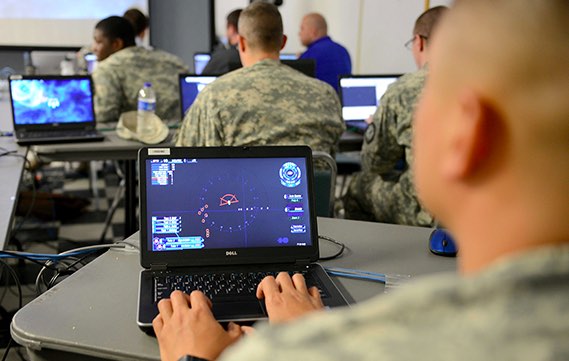 (DOD photo)
(DOD photo)
As I recount in an article published in Counterpunch on November 19, 2005 titled R.I.P In These Times, the left-liberal news magazine had been promptly bombarded with letters criticizing my article after it came out. The critiques were not about the main topic of the article, which was evidence discovered in medical studies done on returning Iraq veterans from a unit of New York National Guard soldiers, funded by the New York Daily News and reported on by Juan Gonzalez, which had found evidence of exposure to depleted uranium dust that was causing serious health damage in these soldiers, and even birth defects in their young children. Those findings were undeniable. What attracted the critical mail, which would now be called trolling, was my reporting on how much depleted uranium weapons had been dumped on Iraq by invading and occupying US forces.
Based on my research into reports, mostly by European sources, I had written in that article:
U.S. forces first used DU in the 1991 Gulf War, when some 300 tons of depleted uranium–the waste product of nuclear power plants and weapons facilities–were used in tank shells and shells fired by A-10 jets. A lesser amount was deployed by US and NATO forces during the Balkans conflict. But in the current wars in Afghanistan and, especially, Iraq, DU has become the weapon of choice, with more than 1,000 tons used in Afghanistan and more than 3,000 tons used in Iraq. And while DU was fired mostly in the desert during the Gulf War, in the current war in Iraq, most of DU munitions are exploding in populated urban areas.
The Pentagon has expanded DU beyond tank and A-10 shells, for use in bunker-busting bombs, which can spew out more than half a ton of DU in one explosion, in anti-personnel bomblets, and even in M-16 and pistol shells. The military loves DU for its unique penetration capability–it cuts through steel or concrete like they’re butter.
In later years, I’ve done more reporting on the US military’s use of depleted uranium, which the Pentagon loves because of its unique ability to penetrate even thick solid steel tank armor and reinforced concrete bunkers with ease, bursting into intense flame on impact and spreading super toxic uranium oxide dust in the aftermath. There is no dispute about the use of these weapons by US forces. But in 2005, the Pentagon was fighting a brutal rear-guard battle to claim the stuff is safe and at the same time that it was not being used in populated urban areas. Both claims were official lies.
